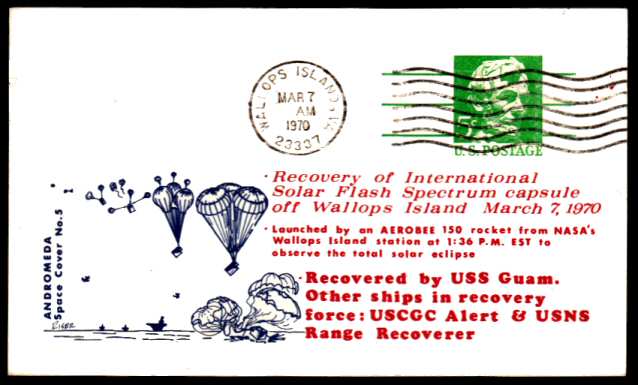![]()

Almost unknown to the general public and receiving little publicity concerning the pending total solar eclipse experiment and supporting recovery operation, a ship recovery force was at sea in the vicinity of Wallops Island, Virginia. The ships were under orders to support recovery of two major International Solar Flash-Spectrum Experiment space capsules to be launched as part of 32 sounding rockets dedicated to be launched from Wallops Island, during a total eclipse of the Sun, March 7, 1970.
The three-ship recovery force included the U.S. Navy's veteran primary recovery ship USS Guam, LPH-9; U.S. Coast Guard ship, USCGC Alert, WMEC-630; and Military Sea Transportation Service tracking ship, USNS Range Recoverer, T-AGM 2.
The total solar eclipse track would cross Mexico and proceed across the eastern seaboard of the United States in the early afternoon of March 7, 1970. NASA's Wallops Island missile test range was directly in the path of the total solar eclipse with the Sun crossing its meridian of longitude at 1:38 pm EST, on this date. An extremely accurate prediction of the solar eclipse resulted in an international team of scientists and astrophysicists requesting a significant experiment to study the hot upper layers of the Sun, as the Moon slowly obscured view of the Sun from Wallops Island and then a total blocking of the Sun as the eclipse progressed for three minutes and mid-day turned into night.
Two rocket flight experiments for the International Solar Flash-Spectrum Experiment were approved by NASA. An Aerobee 150, and a new Aerobee 170 sounding rocket, would release space capsules after acquiring solar eclipse data from their spaceflights to approximately 142 km or 88.2 mile high altitudes and then returning back to Earth. The space capsules then would be recovered by the recovery force and returned by the task force for further analysis and study of post flight data.
Harvard University Observatory, Cambridge, the United States; York University, Toronto, Canada; and the Imperial College of London, England, were directly involved in the experiment. The rocket technology and launch sequence of the experiment was directed by the sounding branch of NASA's Goddard Space Flight Center, Greenbelt, Maryland.
As the International Solar Flash-Spectrum Experiment proceeded during the total solar eclipse on March 7, 1970, the experiment was successfully completed and recovery of the space capsules from the Aerobee rocket flights was made within an hour after their launch from Wallops Island during the eclipse.
A post flight synopsis of test results notes that ionized gases of the outer layers of the solar atmosphere, of the chromosphere, and of the corona had been previously studied during eclipses but other ultraviolet and infrared radiation would be impossible to see, being less bright than light emitted from the Sun's solar sphere.
During the solar eclipse, the extreme ultraviolet and near infrared radiation of the Sun was found to contain much more information about the chromosphere and corona as the temperature of the Sun rises from 6,000 degrees F in the photosphere to 2,000,000 degrees F in the corona. Detailed information also was obtained as the Moon crossed in front of the Sun revealing its atmosphere layer by layer and enabling its structure to be analyzed with greater depth and accuracy than had previously been feasible without occulting of the Sun by the Moon.
Experimentation completed during this solar eclipse involving this group of intensive experiments in the three minutes of total eclipse also lead to a firm foundation in understanding the forces affecting the Sun and their impact on Earth.
Recovery Force Ships
| Ship | Type | Designation | Covers |
|
Atlantic |
|||
|
PRS - Amphibious Assault ShipCarrier |
CVS-18 |
Y ( rare) |
|
|
SRS - Medium Endurance Cutter |
WMEC-630 |
Y ( rare) |
|
|
Tracking & Communications Ships |
|||
|
TS - Tracking Ship |
T-AGM 1 |
Y ( rare) |
|
|
Ship |
Cachet |
|---|---|
|
Andromeda cachet on front |
Notes General:
1) Description thanks to Steve Durst
Notes Other:
i) See letter from USS Guam for more information
ii) See letter from USCGC Alert for more information
![]()
This page © Dr Ross J Smith
This page is maintained by the Webmaster
Last modified on 18 October 2016